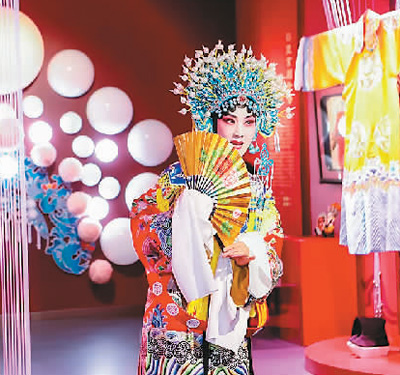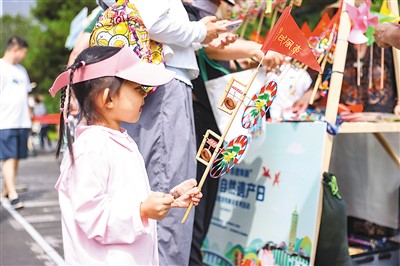Intangible cultural heritage enriches people's lives
The deep integration of intangible cultural heritage (ICH) with other fields such as technology, cultural and creative products, and tourism has opened up new paths for the spread of ICH and helped enrich people's lives.

A performer performs Peking Opera at the intangible cultural heritage exhibition and experience center of Fengtai district in Beijing. (Photo courtesy of the event’s organizer)
The intangible cultural heritage exhibition and experience center of Fengtai district in Beijing was inaugurated ahead of the Cultural and Natural Heritage Day on June 8. As a public cultural platform that integrates preservation, inheritance, exhibition, education tours, cultural exchanges, and recreational entertainment, the center ingeniously leverages technology to showcase the rich cultural and historical heritage of Fengtai district.
Visitors can enjoy an immersive experience of ICH with virtual reality (VR) devices. They can also gain more knowledge about the district's ICH and related stories by interacting with an interactive artificial intelligence (AI) robot after scanning its QR code.
In addition to the intangible cultural heritage exhibition and experience center of Fengtai district, several other newly-unveiled ICH venues across China harness new technologies and develop immersive, thematic, interactive, and characteristic ICH products and scenarios, ensuring thriving market supply and demand and sustainable growth.
In addition, ICH has been popularized online by means such as livestream sessions and short videos.

A girl stands in front of a stall of an intangible cultural heritage (ICH) market held during activities promoting ICH for the 2024 Cultural and Natural Heritage Day in Beijing. (Photo courtesy of the event’s organizer)
Exhibitions of video and photography works about ICH hosted by China's Ministry of Culture and Tourism (MCT) have been rolled out on the country's major internet platforms.
The exhibitions were co-organized by the China Association of Performing Arts (CAPA) and internet platforms including Tencent, iQIYI, Youku, Bilibili, Douyin, and Kuaishou. This year, the exhibitions ran from June 7 to 30.
The exhibitions have been held for five consecutive years. "We aim to better realize our original aspiration of enabling people to appreciate the wonders of ICH online through ICH-related video and photography works accumulated over the past five years, as well as improved interactive methods and new technologies," said Pan Yan, secretary-general of CAPA.
Pan added that over the past four years, selected ICH-related video and photography works have garnered over 720 million views during the Cultural and Natural Heritage Day.
In celebration of this year's Cultural and Natural Heritage Day, the MCT encouraged regions across the country to launch shopping festivals featuring intangible cultural heritage elements to promote the recovery and development of cultural and tourism consumption.
An ICH-themed shopping festival held in Chengdu, capital of southwest China's Sichuan Province, on June 8 showcased various ICH items, including Daoming bamboo weaving, a national-level ICH in Chongzhou city in the province, attracting crowds of both domestic and foreign visitors.
In recent years, Chongzhou has worked with institutes including the Central Academy of Fine Arts and Australian Research Institute for Bamboo Industry, as well as 40 design agencies of cultural and creative products to make its time-honored bamboo weaving culture more creative and aesthetically appealing. As a result, the city has received many overseas orders for bamboo weaving products.

Photo shows children at an intangible cultural heritage class held in Dongyang city, east China's Zhejiang Province. (Photo/Wang Pengxiang)
"Through years of efforts, Chongzhou has achieved gratifying results in the revitalization and utilization of multiple intangible cultural heritage items, including Daoming bamboo weaving," said Bai Jingbo, president of the Chongzhou traditional crafts promotion association.
Bai added that the city has attracted more young inheritors and seen steady growth in exports of ICH-related cultural and creative products to markets including the U.S., Europe, the Middle East, Japan, and South Korea.
"An increasing number of people love China's ICH, and enjoy wonderful lives brought by Chinese culture and craftsmanship," Bai noted.
Over past years, the integration of ICH and tourism has resulted in the emergence of more tourism products with unique cultural elements, and revitalized rich ICH resources, bringing ICH culture closer to people's lives.
Activities promoting ICH for the 2024 Cultural and Natural Heritage Day in Beijing were launched at the Beijing (Tongzhou) Grand Canal Cultural Scenic Area. The city released multiple ICH-themed tourism routes, promoting the integration of ICH into tourist attractions, resorts, and leisure blocks.
"The integration of ICH and tourism has led to more fashionable tourism products and cultural creative products," said Han Yuanjun, an associate researcher at the Institute of Strategy of the China Tourism Academy.
The development of tourism enables more ICH inheritors to increase their incomes, inspiring them to better protect ICH, Han added. In addition, tourism allows more people to learn about ICH items and engage in ICH protection, and drives innovation in ICH projects, injecting fresh vitality into ICH through market forces and extensive public participation.
Photos
Related Stories
- Online platforms promote inheritance of intangible cultural heritage
- UNESCO's Intangible Cultural Heritages in China (II)
- China encourages integrating intangible cultural heritage, tourism
- UNESCO’s Intangible Cultural Heritages in China (I)
- City in China’s Hubei revitalizes ancient Chu-style lacquer decoration technique
- Woodblock paintings depicting West Lake exhibited in Hangzhou
- China's intangible cultural heritages exhibit in Anhui [Video]
- China owns 3rd largest number of world heritage
- Time-honored items shown in Tianjin, N China [Video]
- China's top legislature opens bimonthly session
Copyright © 2024 People's Daily Online. All Rights Reserved.









